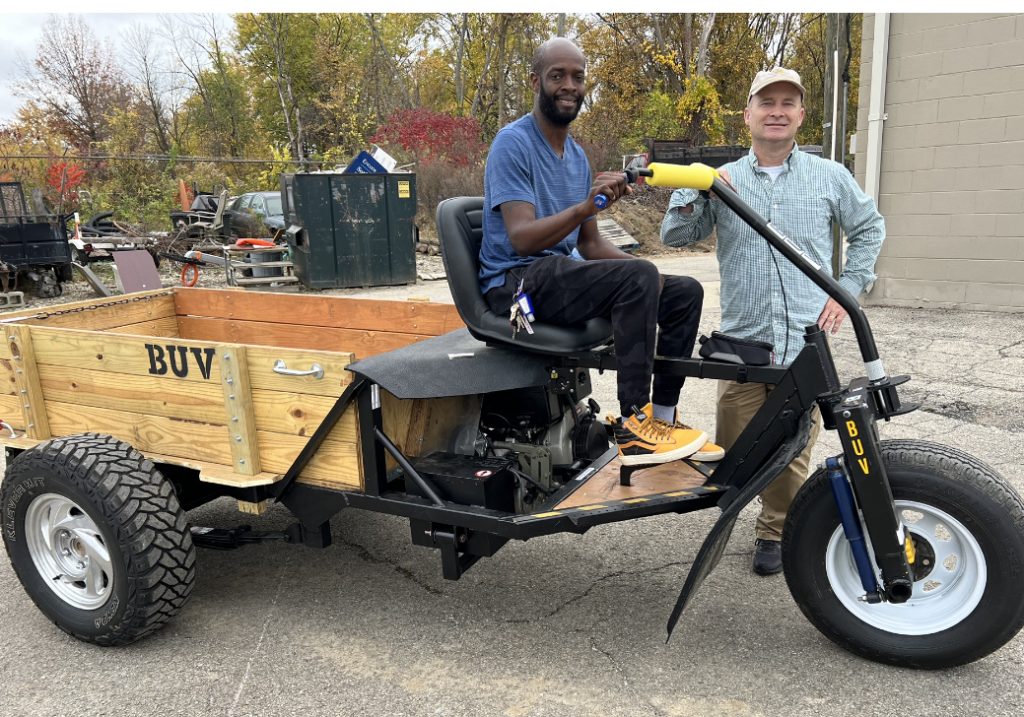Real Problems, Real Solutions: Engineering Students Use DesignSpine Expo to Showcase Real-World Work for Outside Clients

There is nothing like a real-world problem to help university students learn critical thinking, multi-discipline communication skills and client collaboration—whether that problem is how to transform a Basic Utility Vehicle in sub-Saharan Africa to power a water pump and bring water to a family or small village, or how to design a Fluid Control Systems Trainer that demonstrates fluid control principles in real-time. That is the purpose of the DesignSpine curriculum, which forms the backbone of learning at the R.B. Annis School of Engineering at the University of Indianapolis.

A total of twelve DesignSpine projects were presented at the second annual DesignSpine Expo on April 16. The event showcased how University of Indianapolis engineering students are making an impact across the developing world, an impact for Hoosier small farmers as they design a better crimper for cover crops, and an impact on campus for UIndy Police as well as 16 other police departments as they developed a rearward-facing vehicle mount for officers’ body cameras.
“What separates the best engineering students from others is not basic knowledge of math and science concepts—anyone can do that,” said Associate Dean and Director of Engineering Ken Reid. “The separator is the ability to communicate with others, across engineering disciplines as well as to non-engineers. It is a skill which is only gaining in value and necessity in today’s high-tech, global world and it’s one of the building blocks for DesignSpine.”
Each UIndy engineering student, like sophomore Zy’Aire Parker, is placed onto a DesignSpine team in the fall, with a faculty advisor overseeing each team for weekly meetings. Each team has its own external or internal client and project. This year’s clients include the Institute for Affordable Transportation, the Marion County Soil and Water Conservation District and Carrier. Past clients have included Fastenal, Milwaukee Tool and Citizens Energy Group.

Parker and four team members designed a rivet press safety system for C.H. Ellis, a prominent manufacturer of industrial plastic and sewn cases. Even if it wasn’t easy, the project helped confirm she made the right choice in coming to UIndy for college.
Parker says the team had lots of ideas at the beginning of the project and felt confident they could easily find a solution. But as time went on, more limiting factors were discovered when attempting design optimization.
“It definitely confirmed I want to be an engineer,” said Parker. “It did make me think about some of the things that you don’t necessarily think about when you’re a child and you’re like, ‘I just want to build things when I grow up.’”
“It was definitely harder than we thought,” said Parker with a laugh. “Now, looking back on it, it taught me more than I thought in the moment. I learned so much because we went at it from so many different routes. It did definitely confirm that this is something I want to do. I liked it a lot. It taught me a lot for sure.”

The DesignSpine project for the non-profit Institute for Affordable Transportation tackled the challenge of constructing a power take-off system for the Institute’s Basic Utility Vehicle or BUV. The mechanism designed by UIndy students transfers the rotational engine to a water pump capable of pumping thousands of gallons of water an hour to remote regions of Africa.
“I’m really excited about the work they did,” said Will Austin, founder and executive director of the Institute for Affordable Transportation and the BUV Ministry. “I love the fact that this design they did is very flexible for powering multiple types of devices, not just water pumps, but could be a grain mill. It could be a meat grinder. It could be a lot of things that are fully driven.”
Austin said the flexibility offered by the power take-off system or PTO will help with a wide range of tasks of processing crops after harvest. Most of those tasks now have to be done manually.
“So this is a huge help to the local population,” said Austin. “They can make more money, but they also have more time to spend with their family so we love that part. It helps Africa grow.”

Assistant Professor of Engineering Megan Hammond helps oversee the DesignSpine program and has served as a team coach or technical resource for a number of projects over the years. She spearheaded the creation of the DesignSpine Expo last year to highlight the engineering projects and applications for clients as well as a broader audience.
“The Expo is an ideal opportunity to showcase the incredible work our students do each year,” said Hammond. “I want the end of the semester to recognize the hard work, industry collaboration and growth that every student achieves through our DesignSpine program. The Expo gives students a chance to explain the amazing tasks they have accomplished to a larger audience, which is a far better experience and celebration than a private hand-off meeting with the client.”
Meanwhile, Parker is thrilled by the prospect that she has two more years of DesignSpine to go and two more DesignSpine Expos to attend.
“I am excited for whatever the next project is going to be,” said Parker.

